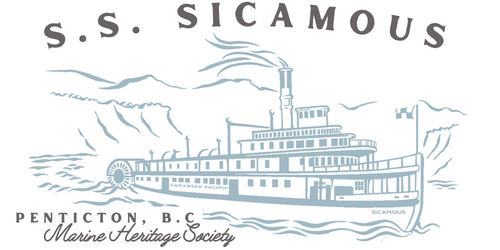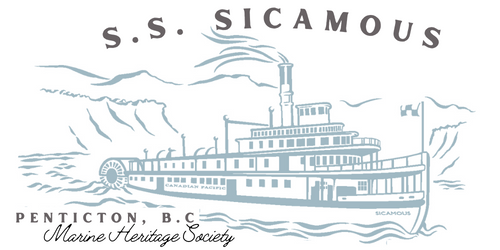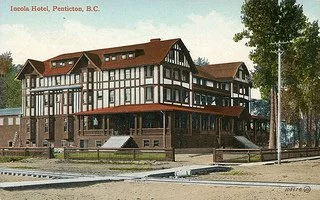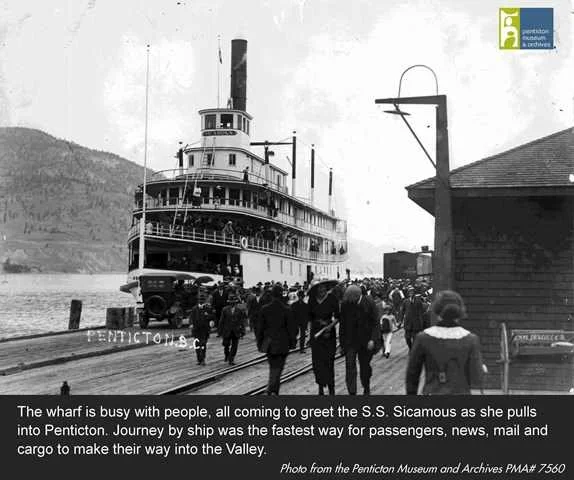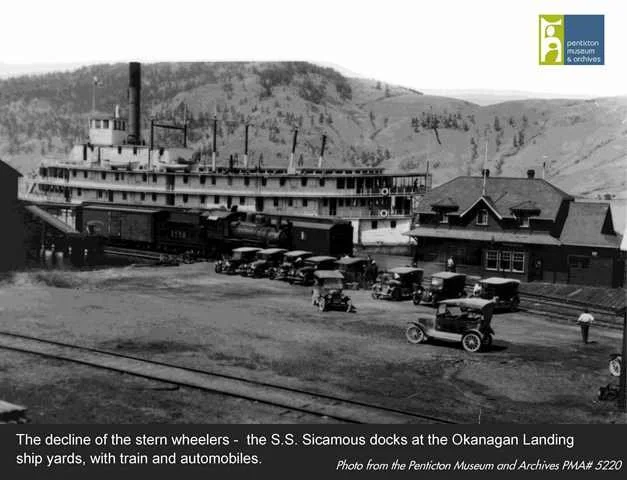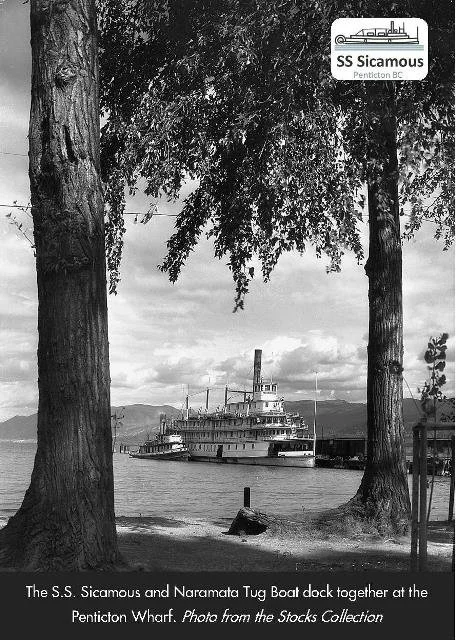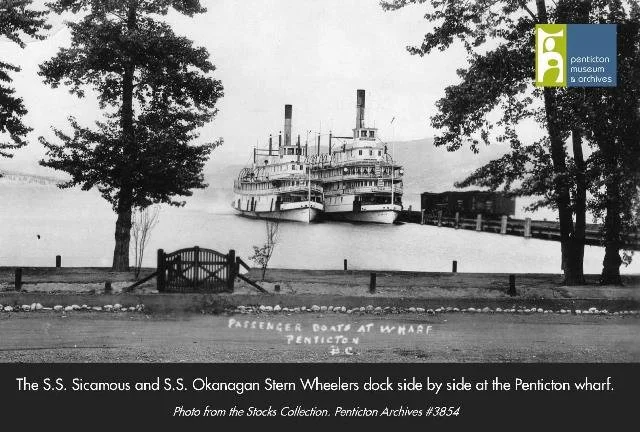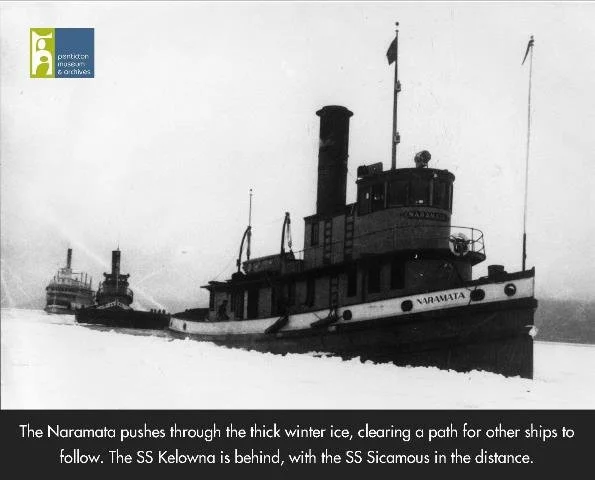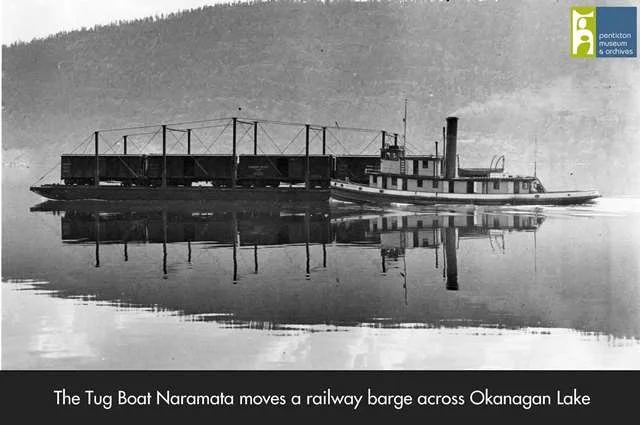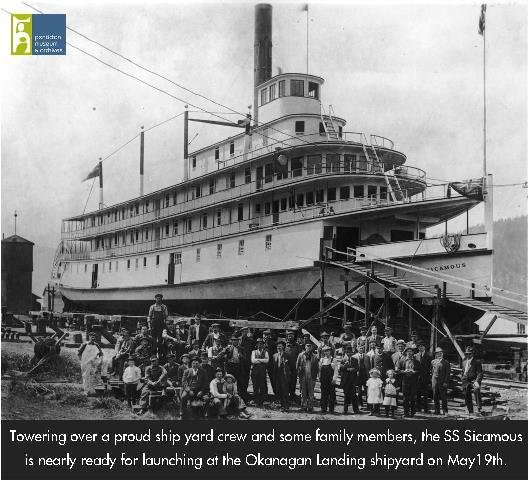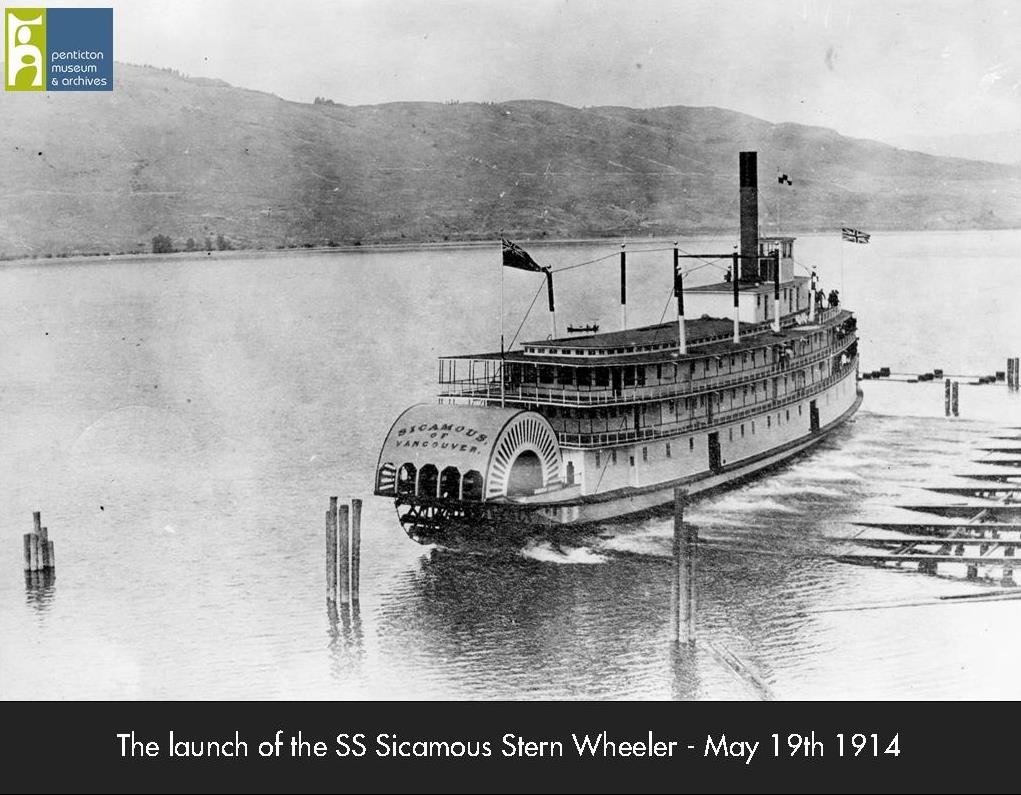
History of the Sicamous
A History of the SS Sicamous Stern Wheeler
Scale Drawing of the Stern Wheeler Sicamous - by Historian Robert Turner
About the Ship
The stern wheeler SS Sicamous is a luxury vessel that was used to transport passengers and cargo to remote communities along the shores of Okanagan Lake.
The ship was launched in 1914 from the Okanagan Landing Shipyards, at the north end of the lake. The Sicamous travelled from Penticton to Okanagan Landing daily (except Sunday) with 14 scheduled stops along the way. Her luxury and beauty attracted crowds at each dock, while travellers experienced elegance in dining and service renowned by Canadian Pacific.
Today the ship is preserved on the shore of Okanagan Lake, in Penticton BC. It open as a museum and heritage site and is cared for by a non-profit organization called the SS Sicamous Marine Heritage Society. The Sicamous is a unique part of Okanagan history and heritage.
Frequently Asked Questions
How long was the SS Sicamous in service?
The S.S. Sicamous was launched on May 19, 1914.
The ship was in service for 22 years (until 1936).
Where did the SS Sicamous Travel?
The Sicamous travelled all along the shores of Okanagan lake, from Penticton in the south up to Okanagan Landing at the north end of the lake. There were 14 scheduled stops throughout, and ship could also make unscheduled stops at smaller settlements (the residents would stand on the shore and wave a white flag, or light two fires at night, to get the attention of the Captain!) The Sicamous would depart from Penticton at 5:30am every day, except Sunday. Weather and schedule permitting, it would be back in Penticton by 8pm each night.
Penticton was once a bustling railway town, and the wharf and railway station could be found together at the base of Martin Street, (close to where the peach concession stand is today). The Railway owned the Incola Hotel just across the road, and this is where many passengers would spend the night.
Map of the stops and Landings on Okanagan lake.
From a vintage brochure published by Canadian Pacific Railways. The thick red line shows the train routes, the thin dotted lines show the lake boat routes.
The Sicamous would depart from Penticton - then on to Arawana (Naramata) - Summerland - Peachland - Gellatly - Kelowna - Okanagan Centre - Nahun Landing - Ewing’s Landing and lastly - Okanagan landing, where passengers could board a train to Vernon.
The Incola Hotel, Penticton
This was a luxury railway owned hotel, intended to rival the Banff Springs. It was at the base of Martin Street, just across from the Penticton wharf and railway station. The Sicamous would dock at 8pm each night, so passengers could depart the ship with their luggage, and easily check in to their rooms.
Has the Sicamous always been in the Okanagan Valley?
The Sicamous has been in the Okanagan ever since her launch in 1914. The steel hull and boiler were actually built in Eastern Canada (in Thunder Bay, Ontario). The hull was transported across Canada by 17 rail cars, and then put together at the Okanagan Landing Ship Yards (at the north of Okanagan Lake) by a team of 150 men. Ship yard workers then began carving the upper decks from imported wood.
Why does it say SS Sicamous of Victoria on the Paddle Wheel?
Like ships today, the Sicamous had to be registered. At the turn of the 20th century, the port of registry was Victoria, so this was proudly written in gold paint on the back of the paddle wheel.
Fun Fact: When the Sicamous was launched a mistake was made, and Vancouver was accidentally written. It was repainted soon after the launch.
SS Okanagan Stern Wheeler on the Lake - From Penticton Archives (Number #5196)
Why is it called the SS Sicamous?
Canadian Pacific Rail (CPR) had a tradition of naming their ships after the communities they served. There was an important railway station in Sicamous BC, and this is where our ship got her name.
Over the years the CPR also launched an SS Kelowna, SS Naramata, SS York, SS Okanagan, SS Slocan, SS Kootenay, SS Moyie and SS Revelstoke too.
The S.S. Kelowna Tug Boat
Did you know?
The SS in each of these names stands for Steam Ship.
How fast could the ship travel?
The Sicamous could reach top speeds of 18 knots (33.8 kph/21 mph)!
The engines were powered by steam from a coal powered boiler. To reach these speeds, the boiler burned up to 17 tons of coal each day. All this coal had to be shovelled by hand. Water was sucked up from the lake, and turned to steam by the heat of the fire. If you visit the ship you can see the pokers, shovels and rakes that they would have used.
What was it like to travel on the Sicamous?
Food: Canadian Pacific was renowned for its 5 star service. Food was grown locally in a company owned garden in Penticton, or sourced from farms and ranches in the valley. Everything was cooked from scratch in the kitchens below, and sent upstairs by dumbwaiter.
Electricity and Hot Water: Unlike many homes in the valley the Sicamous had electricity and hot running water too. Electricity was generated by steam from the boiler, and was used to light the rooms and cabins. There were large bath tubs, and guests could pay 50 cents for the luxury of a hot bath.
Overnight Rooms: The Sicamous didn't actually travel over night, but it did leave very early in the morning. To save time, many guests would board the night before and book a room for the night, to avoid getting up so early. You could book a bunk, a double sized bunk or a whole state room, depending on your budget and the size of the party.
Passengers travelling on board the S.S. Sicamous (ca. 1920).
These guests may have been on the ship as part of a longer journey by train, or they may have been on board for a leisurely day trip on the lake.
Inside the S.S. Sicamous
A rare photo showing the interior of the S.S. Sicamous. This is the dining saloon, which you can find on the second level of the ship. Tables are laid with fine china and silverware shipped all the way from England.
How many people could travel on the Sicamous?
When the ship was first launched the Sicamous could officially carry up to 500 people at a time. There were 30 rooms for overnight stays, and a total of 5 levels. After alterations to the ship in 1935, the maximum number of guests was reduced to 260.
How many people worked on the ship?
When first in service the Sicamous had a crew of 31-33 staff, plus one mail room clerk, and two express room clerks. Room and board was included with the wages.
The Crew of the SS Sicamous
June 1928. This photo was taken to commemorate the retirement of head chef Le Dye (top row, 5th from the left). After a long career in with Canadian Pacific, Mr. Dye decided it was time to return home, and be with his family in China.
First Captain and Officers on the S.S. Sicamous (1914).
From Left to Right Seated: W. Bracewell (Chief Engineer), George L. Estabrooks (Captain), A.G McDonald (Second Officer). From Left to Right Standing: A.A. McDonald (Purser), J.F. McRae (Second Engineer), A.G. Loomer (Expressman), Otto L. Estabrooks (first officer), W. Ferguson (Steward).
Why were these ships so important to communities in the Valley?
Before the rise of the automobile, journey by ship was the fastest and easiest way to travel in the Okanagan. The lake boats would have carried everything needed for daily life and commerce. The motorways hadn't been built yet, and the tracks for the Kettle Valley Railway were still being laid. Ships were the only reliable and efficient way for mail, people and cargo to travel.
The cargo deck of the Sicamous would have contained fruit and vegetables from the farms and orchards, livestock such as pigs or horses, machinery or supplies for building the KVR, and many other items besides. The CPR also had a contract for the mail routes, so letters and parcels would be transported inside. The upper levels of the ship were reserved for passengers. The trip from North to South would take about 8 hours (or a 16 hour round trip).
Why did the lake boats stop?
A few short years after the launch of the Sicamous, life in the Okanagan began to change.
The Kettle Valley Railway (KVR) line to Penticton was completed in 1915. The new railway line was greeted with much fanfare and dramatically improved access to the South of the valley. As the new headquarters for the KVR, Penticton soon became a bustling railway town.
The motorways were also completed in the 1930s, and motorcars increased in importance, further reducing reliance on the lake boats.
While the ships were still important for linking the North and the South of the lake, demand for passenger service provided by the stern wheelers dropped. The tug boats lasted much longer, with the last one operating until 1973.
The Decline of the Lakeboats
The SS Sicamous waits at the Okanagan Landing Railway Station (a short journey from the City of Vernon). A train has pulled up alongside so passengers can easily board. Parked beside the railway is a collection of automobiles - a form of transport that was quickly gaining in popularity. After the construction of the motorways, travel by car was a cheaper quicker option for many.
When did the Sicamous stop running?
The Sicamous was retired from service in 1936.
What happened to the Sicamous after it was retired?
After her retirement, the SS Sicamous was stripped of valuables and tied up at the Okanagan Landing Ship Yards (close to the City of Vernon). For over a decade the SS Sicamous floated quietly, all through the Second World War and into the busy post-war years. There was little to attract attention to the steamer, and it was clear that the CPR would never run the ship again.
How did the Sicamous end up in Penticton?
The Sicamous docked in Penticton each night, and departed from here each morning, so local residents always considered the ship their own.
While the vessel was tied up at the ship yards there were rumours of other buyers but these all fell through. In 1949 the City of Penticton was approached by the Penticton Gyro Club, who wanted to use the ship as their club house. Together they arranged to purchase the ship from Canadian Pacific. She was towed back home to Penticton on a wet and windy day in August of 1951.
The Final Journey to Penticton
A solitary man waves at the Sicamous as she makes her final journey down the lake. The ship is being pushed by the M.V Okanagan, as sadly she was unable to make the journey under her own steam.
The SS Sicamous arrives home in Penticton
Crowds come to greet the Sicamous on a rainy day in August of 1951. Next they will dig a trench, and the ship will be pushed and secured. She is still there today, beside the beach in Penticton BC.
Where can I find old photos of the lake boats?
The Penticton Museum and Archives has an extensive collection of photography of the lake boats, railways, and communities on the Okanagan. Many of the photographs have also been digitized, and are available free of charge to researchers and interested members of the public.
If you look carefully at each of the pictures on this site, you will notice an archive number. This can be used to easily find and request a photo in the Penticton Archive collections.
Here are some of our favourite photos from the Penticton Archives...
Resources for Learning
History Books and Articles
If you would like to research the history of the Okanagan lake ships under your own steam, the local Penticton Library has an extensive local history section. Click here to see the online catalogue: The Penticton Library. The Penticton Museum and Archives are in the same building, so you can easily combine a visit!
Old Newspaper Articles (from the Penticton Herald)
View the full collection of Penticton Herald Newspaper articles, dating from the early 1900's onward. Contact the Penticton Archives to book an appointment. The SS Sicamous Society also has a selection of typed articles and text online. Click here to see a snap shot of life in the valley: SS Sicamous and the Penticton Herald Newspaper.
Okanagan Historical Society Journals
The entire journal collection has been digitized and can be accessed online for free! There are lots of articles about the Sicamous, the stern wheelers and the tug boats too. Click here to see the online collections from the Okanagan Historical Society: Okanagan Historical Society
Archive Materials, Letters, Log Books and Photos
For archive materials relating to the lake ships you can contact the Penticton Museum and Archives. There are letters and materials from Jack Petley, ship plans and blue prints, ship log books and more at the Penticton Museum and Archives. The archives are open by appointment, from Wednesday to Friday (10am to 4:30pm) . To book a visit at the Penticton Museum and Archives, or to learn more, please call: 250-490-2453.
Information for Elementary School Teachers
Have a look at the Canadian Pacific Rail History Teaching Pack – Canadian Pacific Rail Children’s Information Pack . We are also happy to offer guided tours for school groups.
Join the Mailing List
Never miss out on news from the SS Sicamous Society.
News and sneak peaks will be delivered straight to your inbox.
